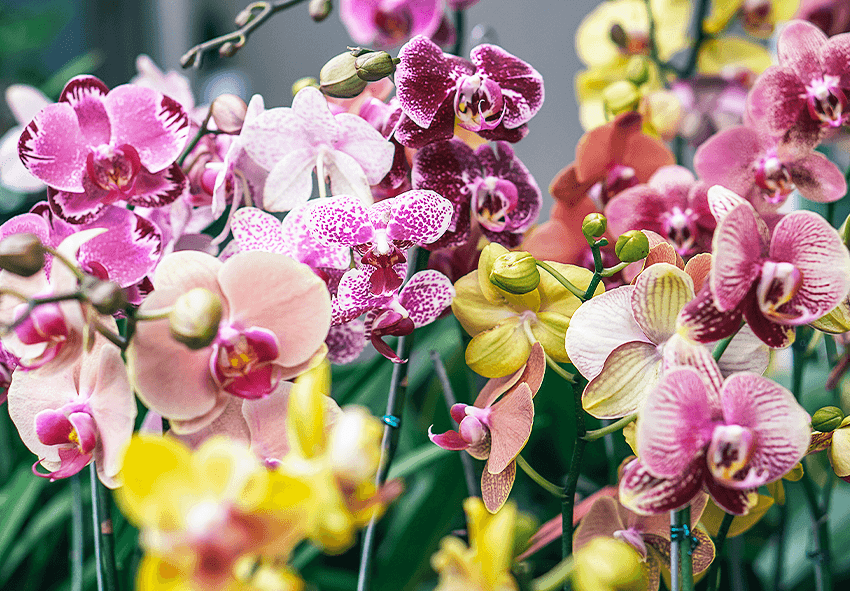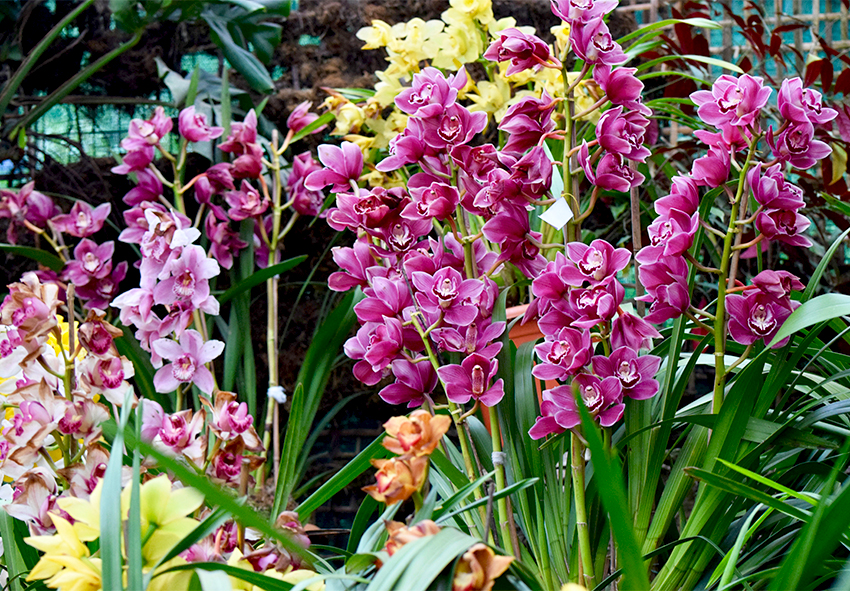Orchids are known for their exotic beauty, intricate blooms, and ability to bring elegance to any garden. More than just indoor houseplants, many orchid varieties can thrive outdoors when properly integrated into a garden design. In this article, we’ll explore how to use orchids in landscaping, covering the best types for outdoor use, design ideas, maintenance tips, and the ideal companion plants to pair with them. Our gardening blog is a perfect place to find all the information you need!
Understanding Orchids for Outdoor Use

Not all orchids are suited for outdoor growing, but several hardy types can flourish in the right environment. Understanding the specific needs of orchids — light, soil, moisture, and climate — is key to creating a healthy and thriving orchid garden. Before planting, it’s important to choose the right varieties and understand how to replicate their native growing conditions.
Best Orchid Types for Outdoor Gardening
Not all orchids thrive outside, but some varieties are well-suited for garden environments depending on your climate. These hardy types can handle fluctuating outdoor conditions while delivering stunning blooms. Here are the top orchid varieties recommended for outdoor gardening:
- Cymbidium Orchids: Ideal for cooler climates, Cymbidiums can tolerate light frosts and bloom beautifully in late winter to spring. They prefer bright, indirect light and make great potted or garden bed additions.
- Bletilla (Hardy Ground Orchid): A true garden favorite, Bletilla grows from bulbs and thrives in temperate regions. It produces delicate blooms in spring and adapts well to shady spots in borders or woodland gardens.
- Dendrobium Orchids: These versatile orchids vary by species—some thrive in warm zones, others are cooler-growing. Many Dendrobiums work well in pots or hanging baskets under partial shade.
- Epidendrum Orchids: Also known as reed orchids, they grow upright and can handle bright sun. Great for tropical and subtropical gardens, they bloom profusely and require minimal care once established.
- Calanthe Orchids: These semi-deciduous orchids thrive in shaded, moist woodland-style gardens. They flower in spring and prefer well-draining, humus-rich soil.
- Pleione Orchids: Suited for cool climates, Pleiones are ideal for rock gardens and containers. Their spring blooms are vibrant and eye-catching, and they require a dormant period in winter.
Growing Conditions and Climate Considerations
Orchids vary in their climate preferences. Cymbidiums and Bletillas handle cooler temperatures, while tropical orchids like Vanda need warmth and humidity. Most orchids prefer dappled or indirect sunlight, high humidity, and good air circulation. Choose varieties that match your USDA zone or be prepared to protect them during seasonal changes.
Soil, Drainage, and Potting Options
Good drainage is essential for orchids. Use a loose, well-aerated mix such as bark, perlite, and peat moss rather than regular garden soil. In the landscape, consider raised beds, rock gardens, or even mounting orchids on driftwood or trees. Avoid waterlogged areas, which can quickly lead to root rot.
Orchid Garden Design Ideas
Orchids can elevate your garden’s aesthetic by adding a unique tropical feel and architectural elegance. Whether you’re creating a focal point or complementing an existing design, orchids provide color and interest. With the right styling and placement, they can become a show-stopping feature in your landscape.
Orchid Landscaping Styles
Tropical-style gardens benefit greatly from lush orchid displays combined with palms and ferns. For a modern look, integrate orchids into minimalist settings using neutral-toned planters and geometric layouts. Woodland or shaded gardens are perfect for terrestrial orchids like Bletilla, which blend naturally with moss and forest plants.
Color and Bloom Planning

Thoughtful color and bloom planning with orchids can transform your garden into a stunning, year-round visual display. By selecting varieties with complementary hues and staggered bloom times, you’ll ensure ongoing interest and a harmonious aesthetic. Here are key tips for planning your orchid garden by color and bloom cycle:
- Choose a Consistent Color Theme: Select orchids in similar tones—such as whites and pinks for a romantic garden, or bold purples and oranges for a tropical look—to maintain visual cohesion.
- Use Contrasting Colors for Visual Impact: Pair bright-colored orchids (like yellow or magenta) with deep greens or dark-foliaged companions to create striking focal points.
- Layer Cool and Warm Tones: Combine warm hues (reds, corals) with cooler ones (lavenders, blues) for depth and balance across your orchid beds.
- Plan for Staggered Blooming Seasons: Include early, mid, and late-season bloomers (like Cymbidium, Dendrobium, and Phalaenopsis) to extend flowering periods and keep your garden lively throughout the year.
- Incorporate Foliage for Off-Season Interest: Add colorful or textured foliage plants (like hostas or ferns) to maintain garden appeal when orchids are not in bloom.
- Use Bloom Size and Shape to Guide Placement: Position large, bold blooms in central locations, while delicate or miniature orchids can fill in edges or tucked-away spots.
Placement and Layering in the Garden
Orchids work beautifully as focal points, whether in a planter by the entrance or elevated in a raised bed. Layer them alongside mosses, bromeliads, or low-lying groundcovers for a textured, multi-tiered design. Ensure each orchid receives adequate air and light by spacing them properly.
Orchid Maintenance in Garden Settings
Proper care ensures your orchids not only survive but thrive in a garden environment. Once planted, focus on consistent moisture, feeding, and seasonal adjustments. Outdoor orchids will reward you with rich foliage and vibrant blooms when their basic needs are met.
Watering and Feeding Schedule
Orchids prefer moist but not soggy roots. Water early in the day to allow leaves to dry before nightfall, reducing fungal risk. Fertilize every 2–3 weeks during the growing season with a balanced, orchid-specific fertilizer diluted to half strength to avoid overfeeding.
Seasonal Orchid Care
In cooler regions, protect orchids from frost with garden fabric or by moving potted orchids indoors. Trim back spent flower stalks and remove dead leaves to promote airflow and prevent disease. Some orchids go dormant after blooming — reduce watering during this period to avoid rot.
Common Problems and Solutions
Pests like mealybugs, aphids, and slugs can target orchids. Regularly inspect your plants and use natural pest controls like neem oil if needed. If your orchid isn’t blooming, it may need more light or a feeding adjustment. Yellowing leaves may signal overwatering or poor drainage.
You can find more useful information about pest and disease control in our expert guide for orchids.
Companion Plants for Garden Orchids

Pairing orchids with the right companion plants can enhance their growth and visual appeal. The goal is to create a supportive microclimate while maintaining aesthetic harmony. Choose plants that complement orchid needs without competing for resources.
Ideal Companion Plant Options
Choosing the right companion plants can greatly enhance the growth and appearance of your garden orchids. These supporting plants not only complement orchids visually but also help maintain a balanced microclimate by retaining moisture, improving soil health, and creating natural shade. Below are excellent companion plant options that thrive under similar conditions as many outdoor orchids:
- Ferns: Their soft, feathery foliage contrasts beautifully with orchid blooms and provides gentle shade and humidity retention.
- Hostas: Ideal for shaded areas, hostas add lush ground cover and complement orchids with their bold, textured leaves.
- Bromeliads: These tropical companions thrive in similar light and moisture conditions, adding color and structure to orchid beds.
- Caladiums: Known for their vibrant, heart-shaped leaves, caladiums provide color when orchids are not in bloom and enjoy the same warm, humid environment.
- Heucheras (Coral Bells): Their colorful foliage and tolerance for partial shade make them excellent companions that won’t overpower orchids.
- Astilbes: With their airy plumes and shade tolerance, astilbes add height and softness while thriving in similar moist, well-drained soil.
- Japanese Forest Grass (Hakonechloa): This ornamental grass adds a graceful touch and thrives in part shade, enhancing the elegance of orchid plantings.
Avoiding Incompatible Plant Pairings
Avoid fast-growing or invasive plants that can choke orchids or block sunlight. Aggressive root systems may also steal nutrients and water. Ensure companion plants don’t overshadow orchids, particularly those that require partial sunlight for blooming.
Conclusion
Orchids bring a touch of luxury and beauty to any garden setting, offering a wide range of design possibilities. With the right variety, proper placement, and attentive care, your outdoor orchid display can become the star of your landscape. Browse our online store to explore stunning orchid varieties and gardening essentials to start designing your perfect orchid garden today.
Frequently Asked Questions (FAQs) about Orchids in Garden Design
1. Can orchids really thrive outdoors in a home garden?
Yes, many orchid varieties can thrive outdoors if planted in the right conditions. Hardy types like Cymbidium, Bletilla, and Epidendrum are excellent for outdoor settings. Ensure proper light, humidity, and temperature ranges are met based on your climate zone for best results.
2. What is the best location to plant orchids in the garden?
Choose a spot with dappled sunlight, protection from strong winds, and good air circulation. Avoid full, direct sun unless growing sun-tolerant species like Epidendrum. Well-draining soil or mounted setups on trees or rocks also help mimic natural orchid habitats.
3. How do I care for orchids in colder seasons?
For areas with frost or freezing temperatures, bring tender orchids indoors or cover them with frost cloth. Hardy types like Bletilla can tolerate mild cold, but mulching around the base helps insulate roots. Reduce watering during dormancy to avoid rot.
4. Can I order orchids from your online store?
Yes, you can! Our online store Dutch-bulbs.com offers a wide selection of orchid plants, including different varieties and colors. We take pride in providing top-quality plants that are carefully cultivated and shipped with care to ensure they reach you in perfect condition.
5. What are some good companion plants for orchids?
Ferns, bromeliads, hostas, and mosses pair beautifully with orchids. These companions share similar moisture and shade preferences, enhancing both visual appeal and plant health. Avoid aggressive growers or deep-rooted species that may compete with orchid roots.
Published: 27.06.2025
